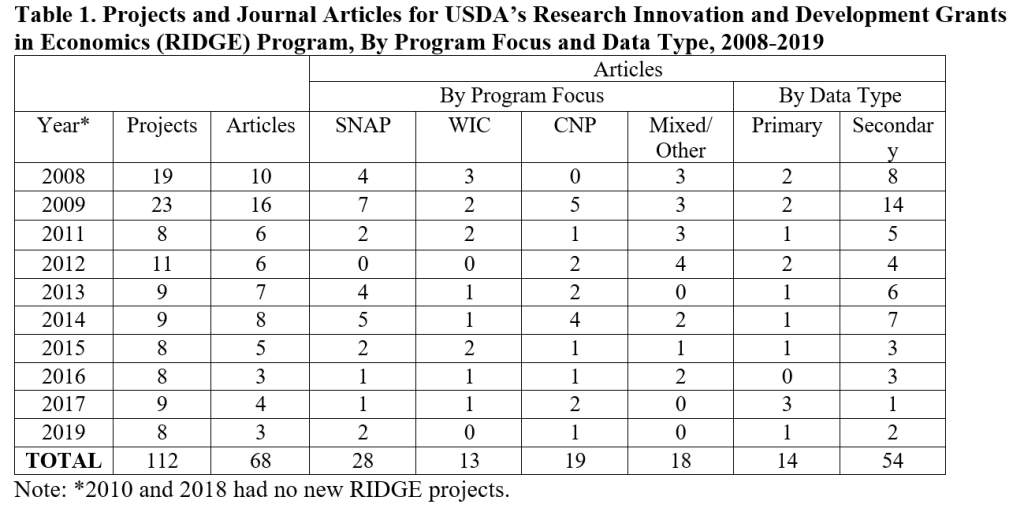Parke Wilde and Tatiana Andreyeva (2022)
In June 2021, the Biden administration’s proposed federal budget for fiscal year 2022 (FY2022) included the largest-ever $13.5 billion increase in non-defense research spending, with a notable shift from basic research toward applied research that addresses national challenges such as climate change and health (1). For USDA, domestic food and nutrition assistance program spending reached a record-breaking $122 billion in FY2020. This growth was prompted by a rapid increase in need combined with implementation of new initiatives to address the COVID-19 pandemic, such as the Pandemic Electronic Benefit Transfer (P-EBT) program for the distribution of food benefits through normal retail channels and the Food Box Program for direct in-kind food distribution (2). The Supplemental Nutrition Assistance Program (SNAP), the largest federal nutrition assistance program, served 40 million participants per month, a 12% increase from the previous year. The pandemic also required major adjustments for federal school meals programs, as many schools transitioned to distance-learning or hybrid modes. In a time of such program change, spending growth, and threats to food security, the value of a diverse portfolio of applied research on federal nutrition assistance programs comes clearly into focus.
This diverse portfolio has long included several mechanisms to fund research on federal nutrition assistance:
- Large-scale extramural contracts from USDA’s Food and Nutrition Service (FNS) and grants through the National Institute of Food and Agriculture (NIFA). For example, the School Nutrition and Meal Cost Study, funded by FNS, plays an important role in confirming the adequacy of per-meal reimbursements for the National School Lunch and School Breakfast Programs.
- Intramural USDA research. For example, the recent update from FNS to the Thrifty Food Plan (TFP) motivated the largest increase in SNAP benefit levels in decades, and the annual food security reports from the USDA’s Economic Research Service play a major role in national discussions of hunger prevention.
- Smaller-scale extramural research. For example, USDA’s Research Innovation and Development Grants in Economics (RIDGE) has for more than 20 years supported smaller research grants through programs administered with university partners around the country (3).
RIDGE funding provides small grants to encourage independent research into local, state and federal food and nutrition programs. This early support can inspire junior researchers to explore nutrition-related research questions on a small scale; or to collaborate with colleagues from other institutions. RIDGE research can be very local or can provide a novel perspective on a national database. Emerging researchers can receive access through third-party agreements (TPAs) with USDA/ERS to important but costly commercial datasets.
In a review of projects funded between the Great Recession (2008) and the most recent year of awards (2021), we found that RIDGE researchers generated 68 articles in refereed scholarly journals and many more publications for lay audiences.

As the largest federal nutrition assistance program, SNAP was the focus for the plurality of articles, and there was heavy coverage of child nutrition and other smaller programs. Due to the small grant format, these projects used comparatively affordable data sources. A substantial majority of projects used federal survey data and other secondary data sources, and many employed feasible primary sources through small surveys and qualitative interview samples. For example:
- With a 2008 RIDGE grant, Angela Odoms-Young, Shannon Zenk and Noel Chavez studied the availability of fruit and vegetables at WIC vendor locations in select communities in Northern Illinois in advance of the distribution of WIC cash vouchers. This early work became part of a longer study that looked at the impact of the WIC vouchers on the availability, selection and prices of fruit and vegetable prices in the same communities (4).
- With a 2009 RIDGE grant, Anita Dupuis, from the Confederated Salish and Kootenai Tribes (CSKT) proposed “to revitalize wellness by means of a cultural immersion experience that reproduced as closely as possible a former lifestyle with it higher level of health” on the Flathead Indian Reservation in Montana. In a 2014 reflection in American Indian Culture and Research Journal, she and Cheryl Ritenbaugh of the University of Arizona noted that some of the original ambitious vision of transformative encampments “was found to be neither feasible nor acceptable” to participants, but the broader intention to use ancestral ways in motivating nutritional change had lasting influence in the community (5). During the same period, RIDGE made related grants to researchers with the Hopi Nation in Arizona and indigenous communities in Oklahoma and Washington.
- With RIDGE grants in 2013, 2016 and 2019, Irma Arteaga has investigated interactions between household participation in SNAP and well-child visits during the first year of a child’s life; the coverage gap between the end of eligibility for WIC and the beginning of participation in NSLP benefits; and the impact of participation in the NSLP on household food insecurity among food-insecure families (6, 7).
- With a 2019 RIDGE grant, Pourya Valizadeh and Shu Wen Ng conducted an analysis of the nutritional impacts of changes made to school breakfasts and lunches through the Healthy, Hunger Free Kids Act (HHFKA) of 2010, specifically estimating “the overall, direct, and indirect effects of the HHFKA on dietary quality of school-age children” (8)
The impact of RIDGE, then, includes nurturing early-career scholars, focusing on smaller nutrition assistance programs and underserved populations, and taking risks on innovative approaches that are uncertain of success. Simultaneously, the RIDGE program serves to protect and support the long-term outlook for nutrition research overall. In summary, RIDGE researchers and projects are making a quantifiable impact on the field.
We are not alone in observing the value of investing in smaller-scale, extramural research through programs like RIDGE. In 2020, the National Academies noted the role of USDA’s historical investments in smaller-scale extramural research, including improving researchers’ access to data (9). Cooperative agreements and external research collaborations have been offered through grant programs administered by the National Bureau of Economic Research grants program, the University of Kentucky Center for Poverty Research (UKCPR), and several iterations of RIDGE collaborations with the University of Wisconsin, University of Michigan, and the current RIDGE Partnership grants in 2023 and 2024. As one part of a balanced portfolio that also includes large-scale program evaluation contracts and intramural research at USDA’s ERS and FNS, smaller-scale extramural research permits useful diversity in new research methods, breadth of program coverage and geographic location, and human capital investments in early-career researchers.
- Mervis J, Malakoff D. Applied research gets big role in Biden’s budget. Science 2021; 1020-1021.
- Toossi S, Jones JW, Hodges L. The Food and Nutrition Assistance Landscape: Fiscal Year 2020 Annual Report. USDA Economic Research Service. 2021; Aug 16 (No. 1962-2021-2614).
- USDA Economic Research Service. RIDGE Program. Updated August, 2021. Accessed November, 2021. https://www.ers.usda.gov/topics/food-nutrition-assistance/food-assistance-data-collaborative-research-programs/ridge-program/
- Zenk SN, Odoms-Young A, Powell LM, Campbell RT, Block D, Chavez N, Krauss RC, Strode S, Armbruster J. Fruit and vegetable availability and selection: federal food package revisions, 2009. American Journal of Preventive Medicine. 2012 Oct 1;43(4):423-8.
- Dupuis A, Ritenbaugh C. Preventing Cardiovascular Disease in Native Communities: The Traditional Living Challenge. American Indian culture and research journal. 2014 Jan 1;38(1):101-22.
- Arteaga I, Heflin C. Participation in the National School Lunch Program and food security: An analysis of transitions into kindergarten. Children and Youth Services Review. 2014 Dec 1;47:224-30.
- Arteaga I, Heflin C, Parsons S. Design flaws: consequences of the coverage gap in food programs for children at kindergarten entry. Applied Economic Perspectives and Policy. 2019 Jun;41(2):265-83.
- Valizadeh P, Ng SW. The New school food standards and nutrition of school children: Direct and Indirect Effect Analysis. Economics & Human Biology. 2020 Dec 1;39:100918.
- National Academies. Consumer Food Data System.
